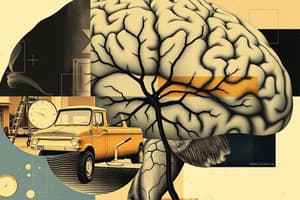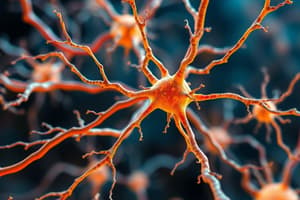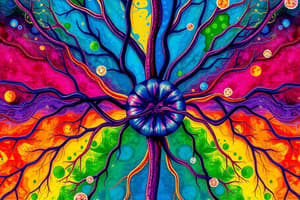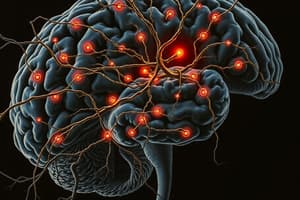Podcast
Questions and Answers
Which part of the central nervous system comprises the brain and spinal cord?
Which part of the central nervous system comprises the brain and spinal cord?
- Cranial Nerves
- Autonomic Nervous System
- Peripheral Nervous System
- Central Nervous System (correct)
The autonomic nervous system controls voluntary movements.
The autonomic nervous system controls voluntary movements.
False (B)
What is the primary function of neurons?
What is the primary function of neurons?
To transmit messages.
The ______ nervous system is responsible for voluntary muscle control.
The ______ nervous system is responsible for voluntary muscle control.
Match the following components with their functions:
Match the following components with their functions:
Which of the following is part of the peripheral nervous system?
Which of the following is part of the peripheral nervous system?
The neuron cell body contains the nucleus.
The neuron cell body contains the nucleus.
What is released from a nerve’s axon terminal to cross the synapse?
What is released from a nerve’s axon terminal to cross the synapse?
Neurons communicate solely through electrical impulses without the need for chemical signals.
Neurons communicate solely through electrical impulses without the need for chemical signals.
What is the term used for the point of contact between two neurons?
What is the term used for the point of contact between two neurons?
The dendrite of the next neuron has receptors that are stimulated by the __________.
The dendrite of the next neuron has receptors that are stimulated by the __________.
Match the following components of a synapse with their descriptions:
Match the following components of a synapse with their descriptions:
What is the ability of neurons to respond to stimuli called?
What is the ability of neurons to respond to stimuli called?
Conductivity in neurons refers to their ability to respond to stimuli.
Conductivity in neurons refers to their ability to respond to stimuli.
What is the collection of sensory neuron cell bodies called?
What is the collection of sensory neuron cell bodies called?
What is the state called when the plasma membrane is polarized with fewer positive ions inside the cell than outside?
What is the state called when the plasma membrane is polarized with fewer positive ions inside the cell than outside?
Cell bodies of motor and inter neurons can be found in ganglia.
Cell bodies of motor and inter neurons can be found in ganglia.
What type of neuron has many extensions from the cell body?
What type of neuron has many extensions from the cell body?
In a polarized neuron, sodium ions ($Na^+$) are ______ outside the cell than inside.
In a polarized neuron, sodium ions ($Na^+$) are ______ outside the cell than inside.
Match the following terms with their definitions:
Match the following terms with their definitions:
Gray matter in the CNS contains ______________ and unmyelinated fibers.
Gray matter in the CNS contains ______________ and unmyelinated fibers.
What occurs first in the generation of a nerve impulse?
What occurs first in the generation of a nerve impulse?
Match the type of neuron with its structure:
Match the type of neuron with its structure:
The nerve impulse can travel in both directions along the neuron.
The nerve impulse can travel in both directions along the neuron.
What describes white matter in the CNS?
What describes white matter in the CNS?
What are the two main ions involved in creating the resting membrane potential in neurons?
What are the two main ions involved in creating the resting membrane potential in neurons?
Bundles of fibers in the CNS are referred to as nerves.
Bundles of fibers in the CNS are referred to as nerves.
What is the primary role of interneurons?
What is the primary role of interneurons?
A reflex arc consists of a sensory neuron, ______ neuron, and an effector.
A reflex arc consists of a sensory neuron, ______ neuron, and an effector.
What is the first step in starting a nerve impulse?
What is the first step in starting a nerve impulse?
Which of the following elements is NOT part of a typical reflex arc?
Which of the following elements is NOT part of a typical reflex arc?
In the PNS, clusters of cell bodies are called ______________.
In the PNS, clusters of cell bodies are called ______________.
Which type of neuron structure has one axon and one dendrite?
Which type of neuron structure has one axon and one dendrite?
Potassium ions (K+) enter the neuron during depolarization.
Potassium ions (K+) enter the neuron during depolarization.
What happens to the charge inside the neuron during depolarization?
What happens to the charge inside the neuron during depolarization?
During repolarization, potassium ions rush ______ of the neuron.
During repolarization, potassium ions rush ______ of the neuron.
How many sodium ions are pumped out by the sodium-potassium pump for every two potassium ions pumped in?
How many sodium ions are pumped out by the sodium-potassium pump for every two potassium ions pumped in?
The exchange of ions during depolarization initiates an action potential.
The exchange of ions during depolarization initiates an action potential.
What is the role of the sodium-potassium pump in nerve impulse propagation?
What is the role of the sodium-potassium pump in nerve impulse propagation?
After an action potential, the membrane returns to its ______ status.
After an action potential, the membrane returns to its ______ status.
What is the net effect of sodium ions entering and potassium ions exiting during nerve activity?
What is the net effect of sodium ions entering and potassium ions exiting during nerve activity?
Flashcards
What is the Central Nervous System?
What is the Central Nervous System?
The master control unit of the body. It processes information received from the body and sends instructions back out.
What is the Peripheral Nervous System?
What is the Peripheral Nervous System?
The part of the nervous system outside the brain and spinal cord that carries messages to and from the CNS.
What is the sensory nervous system?
What is the sensory nervous system?
The system that transmits sensory information from the body to the CNS.
What is the motor nervous system?
What is the motor nervous system?
Signup and view all the flashcards
What is the Autonomic Nervous System?
What is the Autonomic Nervous System?
Signup and view all the flashcards
What is the Sympathetic Nervous System?
What is the Sympathetic Nervous System?
Signup and view all the flashcards
What is the Parasympathetic Nervous System?
What is the Parasympathetic Nervous System?
Signup and view all the flashcards
Irritability
Irritability
Signup and view all the flashcards
Conductivity
Conductivity
Signup and view all the flashcards
Polarization
Polarization
Signup and view all the flashcards
Nerve Impulse Generation
Nerve Impulse Generation
Signup and view all the flashcards
Reflex Arc
Reflex Arc
Signup and view all the flashcards
Ganglia
Ganglia
Signup and view all the flashcards
Nuclei
Nuclei
Signup and view all the flashcards
Tracts
Tracts
Signup and view all the flashcards
Nerves
Nerves
Signup and view all the flashcards
Multipolar neurons
Multipolar neurons
Signup and view all the flashcards
Bipolar neurons
Bipolar neurons
Signup and view all the flashcards
Unipolar neurons
Unipolar neurons
Signup and view all the flashcards
Gray matter
Gray matter
Signup and view all the flashcards
White matter
White matter
Signup and view all the flashcards
Resting Potential
Resting Potential
Signup and view all the flashcards
Action Potential
Action Potential
Signup and view all the flashcards
Sodium Influx
Sodium Influx
Signup and view all the flashcards
Potassium Efflux
Potassium Efflux
Signup and view all the flashcards
Sodium-Potassium Pump
Sodium-Potassium Pump
Signup and view all the flashcards
Nerve Impulse Propagation
Nerve Impulse Propagation
Signup and view all the flashcards
Neurophysiology
Neurophysiology
Signup and view all the flashcards
Membrane Potential
Membrane Potential
Signup and view all the flashcards
What is a synapse?
What is a synapse?
Signup and view all the flashcards
What is a neurotransmitter?
What is a neurotransmitter?
Signup and view all the flashcards
How do nerve impulses travel across a synapse?
How do nerve impulses travel across a synapse?
Signup and view all the flashcards
What is the postsynaptic membrane?
What is the postsynaptic membrane?
Signup and view all the flashcards
What are the structures of a synapse?
What are the structures of a synapse?
Signup and view all the flashcards
Study Notes
Nervous System Organization
- The nervous system is responsible for organizing and controlling the body's responses.
- It gathers and processes information, resulting in an appropriate response.
- The nervous system has two main parts: central nervous system (CNS) and peripheral nervous system (PNS).
CNS Objectives
- List the general functions of the nervous system.
- Explain the structural and functional classification of the nervous system.
- Define the central and peripheral nervous systems, including their main parts.
- Describe the structure of a neuron.
- Describe the functional and structural classification of neurons..
- Describe the composition of grey and white matter.
Master & Fast Control & Communication System
- The nervous system processes and responds to signals to maintain homeostasis.
- Stimuli are gathered by sensory receptors and the information is interpreted.
- The interpretation results in an output signal which creates a response via effectors.
- This response often affects muscles or glands.
Functions of the Nervous System
- Sensory input: Gathering information from inside and outside the body. Changes are called stimuli.
- Integration: Processing and interpreting sensory input and deciding upon an action.
- Motor output: Producing a response via muscles or glands.
Structural Classification of the Nervous System
- Central Nervous System (CNS): Brain and spinal cord. Involved in processing and coordinating information.
- Peripheral Nervous System (PNS): Includes nerves, cranial nerves, and spinal nerves. These nerves act as communication lines to and from the CNS.
- Nerves are structures composing bundles of axons. Cranial and spinal nerves are examples.
Organization (Divisions) of the Nervous System
- Sensory (afferent) division: transmits impulses from sensors. Includes somatic and visceral sensory fibers.
- Motor (efferent) division: transmits impulses from CNS to effectors. Includes somatic and autonomic nervous system.
- Somatic nervous system: voluntary control of skeletal muscles.
- Autonomic nervous system (ANS): involuntary control of visceral organs (internal organs). Includes sympathetic and parasympathetic divisions.
- Sympathetic: mobilizes body systems during activity.
- Parasympathetic: conserves energy.
Neuron Anatomy
- Neuron: a nerve cell, specialized cells transmitting messages.
- Cell body: contains the nucleus.
- Dendrites: extensions conducting impulses towards the cell body.
- Axons: extensions conducting impulses away from the cell body.
- Axon terminals (presynaptic terminals): branching ends of the axon, containing neurotransmitters.
- Neurotransmitters are chemical messengers, enabling signals between neurons.
Pre and postsynaptic cells
- Presynaptic cell: transmits signal.
- Postsynaptic cell: receives signal.
- Synapse: point of contact between two cells.
- Synaptic cleft: gap between neurons.
Axons and Nerve Impulses
- Axons end in axonal terminals.
- Axonal terminals contain neurotransmitter vesicles.
- The next neuron is separated by a synaptic cleft.
- Synapse is the junction between adjacent nerves.
Nerve Fiber Coverings- PNS
- Schwann cells produce myelin sheaths, insulating material around axons.
- Nodes of Ranvier: gaps in myelin sheath along the axon.
- Neurilemma is a protective covering around axons in the PNS.
Neuron Classification
- Sensory neurons: afferent neurons transmit impulses from receptors (to CNS).
- Interneurons: found within the CNS.
- Motor neurons: efferent neurons transmit impulses from CNS to effectors.
Neuron Classification (Examples/Location)
- Sensory neuron cell bodies are typically located outside the CNS (peripheral).
- Cell bodies found in a bundle are called ganglia.
- Motor and interneuron cell bodies are found in the CNS (brain & spinal cord).
Peripheral and Central Nervous System
- Peripheral nervous system: carries signals to the CNS, carries signals from the CNS.
- Central nervous system: processes signals and coordinates responses.
Neuron Cell Body & Fibers (CNS v PNS)
- CNS: Nuclei
- PNS: Ganglia
- Bundles of fibers (CNS): Tracts
- Bundles of fibers (PNS): Nerves
Structural Classification of Neurons
- Multipolar neurons: many extensions from the cell body (common in CNS).
- Bipolar neurons: one axon and one dendrite (rare, found in special sensory organs).
- Unipolar neurons: one axon from the cell body (mainly sensory, in PNS).
White Matter vs Gray Matter
- White matter: myelinated fibers / axons
- Gray matter: neuron cell bodies/ axons not covered.
Functional Properties of Neurons
- Irritability: ability to respond to stimuli.
- Conductivity: ability to transmit impulses across the membrane.
- Polarization: membrane at rest, has fewer positive ions inside than outside.
Objectives - Additional Details
- Describe nerve impulse generation and conduction between neurons
- Define reflex arc and its components with examples.
Reflex Arc
- A reflex is a rapid, predictable, and involuntary response to a stimulus.
- Direct route from sensory neuron, to interneuron, to effector.
- It has 5 key components: receptor, sensory neuron, interneuron, motor neuron, and effector.
Reflex Arc: Components
- Component 1: Receptor. Receives input and transduces a stimulus into a nerve impulse.
- Component 2: Sensory neuron. Transmits the impulse towards the central nervous system.
- Component 3: Integration center. Processes the impulse (typically in the CNS)
- Component 4: Motor neuron. Carries the signal away from the integration center.
- Component 5: Effector. Receives the signal and creates an appropriate response.
Types of Reflexes
- Autonomic reflexes: involuntary control of smooth muscle, glands, and cardiac muscle (e.g., blood pressure regulation).
- Somatic reflexes: voluntary control of skeletal muscles (e.g., knee-jerk reflex).
Homeostasis and Negative Feedback
- The body maintains homeostasis through negative feedback mechanisms.
- Feedback loops involve these steps: Stimulus produces a change in a variable (like temp), Receptor detects change, Control center processes info, Effector response is initiated, Response feeds back to modify the stimulus.
Synapse: Transmission events
- Nerve impulses cross synaptic clefts via neurotransmitters.
- Step 1: Impulse reaches axon terminal.
- Step 2: Neurotransmitter release happens into the synaptic cleft where it binds to receptors.
- Step 3: Receptor binding causes a change and an action potential is initiated.
- Step 4: Impulse ceases via inactivation within the dendrite.
Synapse: Structures
- Synaptic end bulb: an enlarged swelling at the end of the axon, containing neurotransmitter-filled vesicles.
- Synaptic cleft: the narrow space separating the axon terminal from the postsynaptic neuron.
- Postsynaptic membrane: membrane on the postsynaptic cell, where receptors bind to initiate a new signal.
CNS Neuroglia (Support cells) - Various types
- Astrocytes: star-shaped cells, anchor neurons, form connections between capillaries & neurons, control chemical environment of the brain.
- Microglia: spider-like phagocytes, dispose of debris (dead cells/cellular wastes).
- Ependymal cells: line the cavities within the brain or spinal cord, to circulate cerebrospinal fluid.
- Oligodendrocytes: produce myelin sheaths around nerve fibers within the CNS.
PNS Support Cells
- Satellite cells: protect neuron cell bodies (in PNS).
- Schwann cells: form the myelin sheaths around nerve fibers in the PNS.
Nerve Fiber Coverings - CNS
- Many nerve fibres have myelin sheaths (produced by oligodendrocytes).
- No neurilemma.
Studying That Suits You
Use AI to generate personalized quizzes and flashcards to suit your learning preferences.




